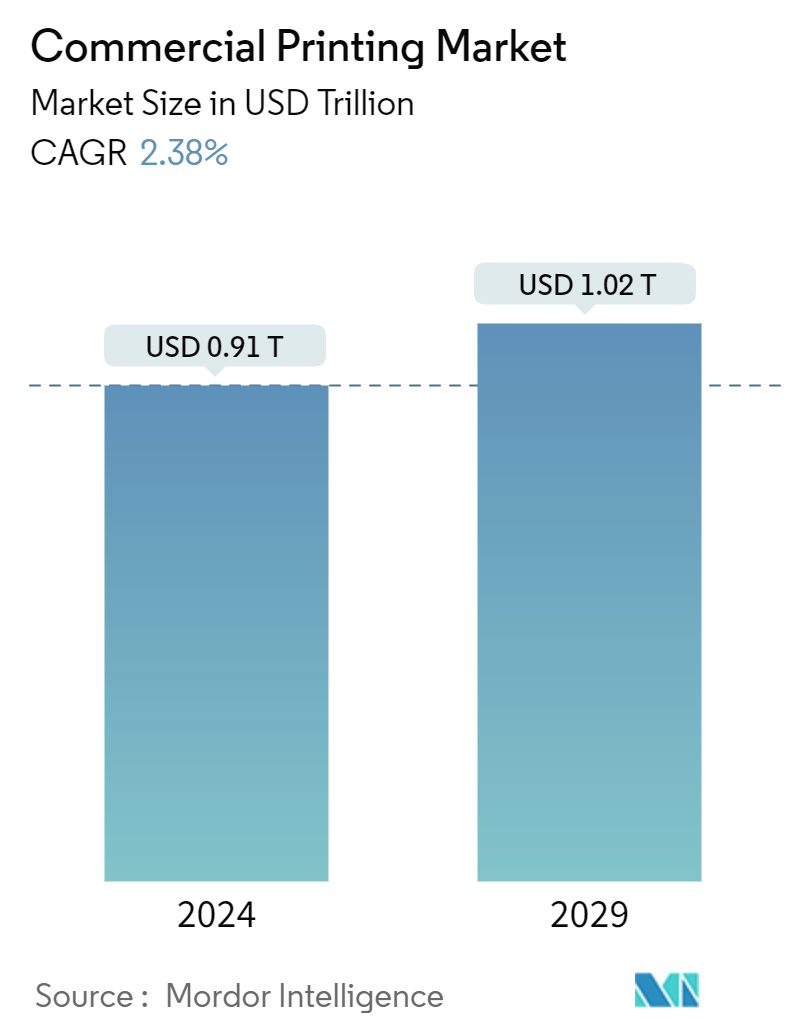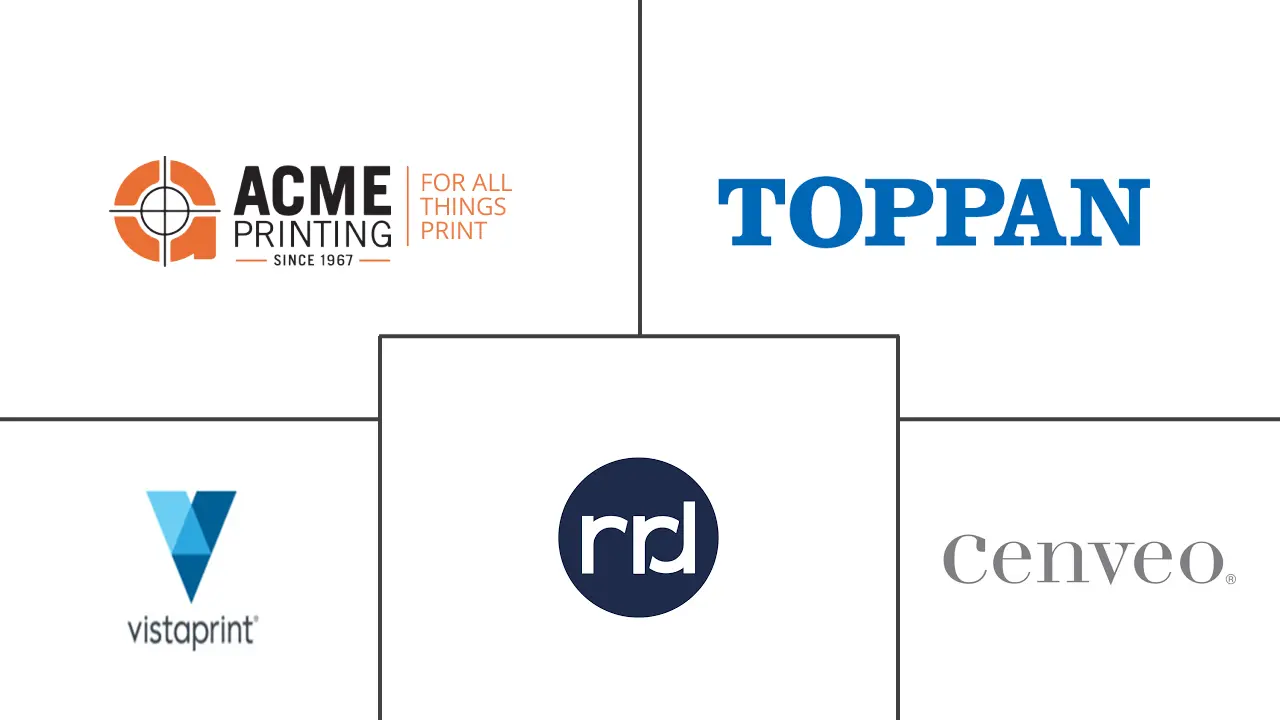Market Size of Commercial Printing Industry

| Study Period | 2019 - 2029 |
| Market Size (2024) | USD 0.91 Trillion |
| Market Size (2029) | USD 1.02 Trillion |
| CAGR (2024 - 2029) | 2.38 % |
| Fastest Growing Market | Asia Pacific |
| Largest Market | Asia Pacific |
Major Players
*Disclaimer: Major Players sorted in no particular order |
Commercial Printing Market Analysis
The Commercial Printing Market size is estimated at USD 0.91 trillion in 2024, and is expected to reach USD 1.02 trillion by 2029, growing at a CAGR of 2.38% during the forecast period (2024-2029).
The commercial printing industry is transforming, primarily driven by the rapid rise of the internet and mobile connectivity. This shift is reshaping how businesses and individuals communicate and access information. Consequently, companies are focusing on producing more targeted and frequent print materials, especially in sectors where consumers are highly engaged.
• Print advertising, a cornerstone of commercial printing, is pivotal for businesses, especially in the retail sector, looking to engage their target markets comprehensively. Print ads offer a unique advantage: they stay in circulation as long as the publication does, potentially promoting a product for months or even years. This longevity, coupled with its effectiveness, is fueling a rising demand for print-based advertising.
• The commercial printing sector is witnessing a significant shift, gradually transitioning toward sustainable practices. Printing industries are increasingly prioritizing environmental concerns, leading to the adoption of various eco-friendly initiatives.
• Moreover, with a growing emphasis on sustainability, businesses are increasingly turning to commercial inkjet products. These products consume less power and emit less carbon dioxide, resulting in cleaner air due to the absence of toner dust emissions. Many companies are investing in inkjet printers to enhance their offerings and personalize packaging, assist clients in brand promotion, and cater to the seasonality of demand.
• The printing industry, historically reliant on labor, has witnessed a shift. Advancements in machinery design, digitalization, and computerization have boosted productivity, decoupling growth from direct labor. However, escalating raw material costs are constraining many market players. These materials encompass paper, inks, and various chemicals.
• According to Zenith, global advertising spending experienced a significant setback in 2020, with a 4% decline, primarily attributed to the COVID-19 pandemic. However, as industries like packaging, publishing, and advertising expanded in the post-pandemic era, ad spending rebounded notably in the subsequent year. Projections suggest that by 2024, the industry is poised to witness a resurgence, with expenditure growth expected to reach approximately 7.6%.
Commercial Printing Industry Segmnentation
Commercial printing refers to producing printed materials on a large scale for commercial use. This type of printing encompasses a wide range of products and services, typically used for advertising, marketing, and communication purposes. Commercial printing is vital in various industries, as it provides standard-quality printed materials that support marketing efforts, enhance brand identity, and facilitate effective communication.
The commercial printing market is segmented by printing type (offset lithography, inkjet, flexographic, screen, gravure, and other printing types), application (packaging, advertising, and publishing (books, magazines, newspapers, and other publishing)), and geography (North America, Europe, Asia-Pacific, Latin America, Middle East and Africa). The market sizes and forecasts are provided in terms of value (USD) for all the above segments.
| By Printing Type | |
| Offset Lithography | |
| Inkjet | |
| Flexographic | |
| Screen | |
| Gravure | |
| Other Printing Types |
| By Application | ||||||
| Packaging | ||||||
| Advertising | ||||||
| ||||||
| Other Applications |
| By Geography*** | |
| North America | |
| Europe | |
| Asia | |
| Australia and New Zealand | |
| Latin America | |
| Middle East and Africa |
Commercial Printing Market Size Summary
The commercial printing market is undergoing a significant transformation, driven by the increasing influence of the internet and mobile connectivity. This evolution is prompting businesses to focus on producing more targeted and frequent print materials, particularly in sectors with high consumer engagement. Print advertising remains a crucial component, especially for the retail sector, due to its lasting presence and effectiveness. The industry is also witnessing a shift towards sustainable practices, with a growing emphasis on eco-friendly initiatives and the adoption of commercial inkjet products that reduce power consumption and emissions. Technological advancements, such as digitalization and automation, have enhanced productivity, allowing growth to be less dependent on labor. However, rising raw material costs pose challenges for many market players.
The Asia-Pacific region, particularly countries like China and India, is experiencing rapid economic growth, which is boosting demand for printed materials across various sectors, including retail, advertising, education, and manufacturing. This economic expansion is driving increased consumer spending, leading to a higher demand for packaging, labels, and promotional materials. Technological innovations in digital printing are further propelling market growth, offering superior quality, efficiency, and customization. The market is characterized by fragmentation, with numerous global and regional players competing on price. Strategic partnerships and acquisitions, such as those by R.R. Donnelley & Sons Company and Konica Minolta Business Solutions, are helping companies expand their service offerings and enhance their market presence.
Commercial Printing Market Size - Table of Contents
-
1. MARKET INSIGHTS
-
1.1 Market Overview
-
1.2 Industry Attractiveness - Porter's Five Forces Analysis
-
1.2.1 Bargaining Power of Suppliers
-
1.2.2 Bargaining Power of Buyers
-
1.2.3 Threat of New Entrants
-
1.2.4 Threat of Substitutes
-
1.2.5 Intensity of Competitive Rivalry
-
-
-
2. MARKET SEGMENTATION
-
2.1 By Printing Type
-
2.1.1 Offset Lithography
-
2.1.2 Inkjet
-
2.1.3 Flexographic
-
2.1.4 Screen
-
2.1.5 Gravure
-
2.1.6 Other Printing Types
-
-
2.2 By Application
-
2.2.1 Packaging
-
2.2.2 Advertising
-
2.2.3 Publishing
-
2.2.3.1 Books
-
2.2.3.2 Magazines
-
2.2.3.3 Newspapers
-
2.2.3.4 Other Publishing
-
-
2.2.4 Other Applications
-
-
2.3 By Geography***
-
2.3.1 North America
-
2.3.2 Europe
-
2.3.3 Asia
-
2.3.4 Australia and New Zealand
-
2.3.5 Latin America
-
2.3.6 Middle East and Africa
-
-
Commercial Printing Market Size FAQs
How big is the Commercial Printing Market?
The Commercial Printing Market size is expected to reach USD 0.91 trillion in 2024 and grow at a CAGR of 2.38% to reach USD 1.02 trillion by 2029.
What is the current Commercial Printing Market size?
In 2024, the Commercial Printing Market size is expected to reach USD 0.91 trillion.

